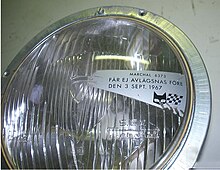Dagen H
[6] The public information campaign leading up to Dagen H included extensive advertising, road markings, and even distribution of reminder items like gloves and stickers to ensure everyone was aware of the change.
[11] As Dagen H neared, every intersection was equipped with an extra set of poles and traffic signals wrapped in black plastic.
Further delay in changing over from left- to right-hand traffic would have greatly increased the cost burden to vehicle owners.
In Stockholm and Malmö, however, the ban was longer – from 10:00 on Saturday until 15:00 on Sunday – to allow work crews to reconfigure intersections.
Experts suggested that changing to driving on the right reduced accidents while overtaking, as people already drove left-hand drive vehicles, thereby having a better view of the road ahead; additionally, the change caused a marked surge in perceived risk that exceeded the actual level, and thus was followed by very cautious behaviour that caused a major decrease in road fatalities.
Indeed, fatal car-to-car and car-to-pedestrian accidents dropped sharply as a result, and the number of motor insurance claims went down by 40%.
The number of motor insurance claims returned to "normal" over the next six weeks and, by 1969, the accident rates were back to the levels seen before the change.
Additionally, many of them were abandoned as a result of Dagen H; only the trams in Norrköping and Gothenburg and three suburban lines in the Stockholm area (Nockebybanan and Lidingöbanan) survived.





